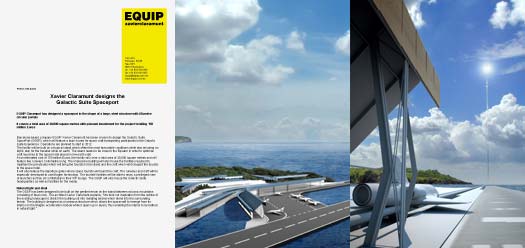Press Release
EQUIP Xavier Claramunt
GALACTIC SUITE SPACEPORT
(Spain)
XAVIER CLARAMUNT DESIGNS THE GALACTIC SUITE SPACEPORT
EQUIP Claramunt has designed a spaceport in the shape of a large, steel structure with 60-metre circular portals
It covers a total area of 40,000 square metres with planned investment for the project totalling 150 million Euros
Barcelona-based company EQUIP Xavier Claramunt has been chosen to design the Galactic Suite SpacePort (GSSP), which will feature a launch area for space craft transporting participants in the Galactic Suite Experience. Operations are planned to start in 2012.
The facility will be built on a tropical island which offers the most favourable conditions while also ensuring an idyllic stay for the traveller while on earth. The island needs to be close to the Equator in order to optimise craft launches to the space hotel placed in low earth orbit.
At an estimated cost of 150 million Euros, the facility will cover a total area of 40,000 square metres and will feature two runways 3 kilometres long. The impressive building will also house the facilities required to maintain the private jets which will bring the tourists to the island and the craft which will transport the tourists to the space hotel.
It will also feature the departure gates where space tourists will board the craft. The runways and craft will be especially developed to use Maglev technology. The tourists’ families will be able to enjoy a privileged view of launches as they sit comfortably in their VIP lounge. The GSSP will also house the Galactic Suite headquarters as well as facilities for the media.
Natural light and steel
The GSSP has been designed to be built on the gentler terrain on the island between volcanic mountains consisting of black rock. The architect Xavier Claramunt explains, “We took our inspiration from the outline of the existing landscape to stretch the building out into radiating beams which blend into the surrounding terrain. The building is designed as a luminous structure which allows the spacecraft to emerge from its interior on the Maglev acceleration module while it opens up in layers, thus enabling the interior to be bathed in natural light.”
The GSSP building is a large structure with sixty-metre circular portals which permit access for planes and space craft as well as to swimming pools, centrifuge facilities and other amenities. Also made of metal, the roofs articulate the technological character of the building while their colour varies as they reflect the sky and sunlight. The interiors also convey the technological, futuristic character of the facilities, thus serving as a counterpoint to the warmer, more comfortable spaces from where the craft launches are observed.
The Barcelona-based company is also designing a hotel and leisure resort for a nearby island, which will accommodate space tourists and their families and provide them with leisure facilities.
Magnetic propulsion system
The architectural company has helped develop a wide range of new technologies as part of the overall GSSP design. The runway will be built over shallow areas in the sea where there is no current, using innovative deep foundation techniques. The whole GSSP complex has been created based on a sustainability study. It will maximise the use of renewable energies while minimising the impact on the environment by recycling waste it generates and using electric transport systems throughout the island.
As far as the launching of craft is concerned, Maglev acceleration systems are being studied which will allow a craft to accelerate along a track about 3 kilometres long, enabling it to attain a speed of about 1,000km/h in a few seconds. The spacecraft will then uncouple from its Maglev acceleration module before using its solid-fuel rocket engine to climb into the sky until it reaches its orbit.
EQUIP Xavier Claramunt
EQUIP Xavier Claramunt was founded in Barcelona in 1990 and operates in three areas: architecture, industrial design and jewellery. It specialises in unique buildings for the hotel sector and comprises a group of thirty professionals with backgrounds in a variety of disciplines.
It has built hotel accommodation in Palma de Mallorca, Jerez and Granada and is currently building three hotels in Barcelona – on the Paseo de Gràcia, near the Arc de Triomf and in El Raval. It is also building around 60 four-star hotels in China, the first of which will be opened before the Olympics in Beijing. It is also the promoter behind the first hotel in space, its star project.
Its clients include renowned companies such as Hospes, Cosmic, Damm, Bra or Faces (Ferran Adrià).

